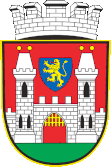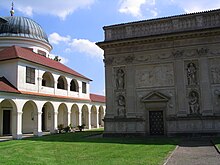Kosmonosy
| Kosmonosy | ||||
|---|---|---|---|---|
|
||||
| Basic data | ||||
| State : |
|
|||
| Region : | Středočeský kraj | |||
| District : | Mladá Boleslav | |||
| Area : | 1161 ha | |||
| Geographic location : | 50 ° 26 ' N , 14 ° 56' E | |||
| Height: | 243 m nm | |||
| Residents : | 5,093 (Jan 1, 2019) | |||
| Postal code : | 293 06 | |||
| structure | ||||
| Status: | city | |||
| Districts: | 2 | |||
| administration | ||||
| Mayor : | Vladimír Dlouhý (as of 2006) | |||
| Address: | Debřská 223/1 293 06 Kosmonosy |
|||
| Municipality number: | 570826 | |||
| Website : | www.kosmonosy.cz | |||
Kosmonosy (German Kosmanos ) is a town with 3917 inhabitants in the Czech Republic . It is located immediately north of Mladá Boleslav at 243 m above sea level. M. and belongs to the Okres Mladá Boleslav . The cadastral area is 1 161 ha.
geography
Kosmonosy is located in the floodplain of the Jizera ( Iser ). Neighboring towns are Debř, Láskov and Bradlec in the west, Chudoplesy in the north and Horní Stakory in the east. To the south, the city has merged with Mladá Boleslav, it borders on the Škoda plant and a large prefabricated housing estate.
In the north-east rise the hills Baba (362 m) and Dědek (349 m), which were declared a nature reserve Vrch Baba u Kosmonos in 1950 .
history
The first documentary mention is in a list of donations to the Order of St. John from 1186.
Between 1560 and 1570 Adam Kraiger von Kraigk had a fortress built in the Renaissance style. In 1650 Hermann Czernin von Chudenitz acquired the rule. A grammar school was attached to the Piarist monastery, founded by Hermann Jakob Czernin von Chudenitz in 1688 , which became the focus of education in the entire Bunzlau district. In place of the wooden church of St. Martin, the Loreto Chapel was built from 1702 , which is considered the architectural gem of the city. From 1703 to 1709 Giovanni Battista Alliprandi redesigned the festivals for Jakob Hermann Czernin von Chudenitz and created a castle with three wings. Humprecht Johann Czernin von Chudenitz granted the place freedom of trade. During the rule of Counts Czernin von und zu Chudenitz , the cruciform church, the Loreto chapel and the campanile were built .
In 1738 the Czernin sold their property in Kosmonosy to the Herzan von Harras . The next owner was Joseph von Bolza , who founded a textile manufacture with bleaching and dyeing on the Iser in 1764, which later became the textile printing factory TIBA.
The monastery was abolished by Josephine reforms and its property went to the religious fund. The grammar school was moved to Jungbunzlau . In 1793, Johann Josef Leitenberger acquired the monastery complex and built a textile factory for printed scarves in it.
In the 18th century the Count Mirbach acquired the place. In 1836, Count Gotthard Mirbach had the palace complex redesigned in Empire style. In 1867 the regional committee acquired the former Leitenberger factory in the old Piarist monastery for conversion into an asylum. A psychiatric hospital has been set up there since 1897.
Under the next owner of the castle, Baron Oskar Klinger, the facade was modernized in 1905. On October 26, 1913, Emperor Franz Joseph elevated the town of Kosmanos to a town.
After the Second World War, Kosmonosy was incorporated into Mladá Boleslav, which had meanwhile expanded to the city limits. In 1954 it regained its independence and was re-affiliated in 1974 against the will of the population. In 1991 the city regained its independence. In 1994 the municipality of Horní Stakory joined Kosmanosy at its own request.
Community structure
The Horní Stakory district ( Upper Stakor ) belongs to Kosmonosy .
Town twinning
- Seeheim-Jugenheim , Germany
Attractions
- Loreto chapel and campanile, built 1702–1708 by Giovanni Battista Alliprandi
- Kosmonosy Castle with an English park
- Nature reserve "Vrch Baba u Kosmonos"
- Church of the Elevation of the Holy Cross, built 1671–1673 by Francesco Caratti , was the first baroque church in the Jungbunzlauer Kreis
- former Piarist monastery , built 1688–1692 by Giovanni Maderno , today a psychiatric hospital, the Kosmonosy sanatorium
Personalities
sons and daughters of the town
- Josef Jiří Jelínek (1697–1776), sculptor and carver
- Alois Bubák (1824–1870), Romantic landscape painter
- Karel Domalíp (1846–1909), electrical engineer and professor in Prague
- Karel Kruis (1851–1917), professor of fermentation chemistry and photography at the Technical University in Prague
- Antonín Stecker (1855–1888), zoologist
- Karel Stecker (1861–1918), professor of organ playing and musical art at the Prague Conservatory
- Gustav Adolf Procházka (1872–1942), bishop and patriarch of the Bohemian Brethren
- Josef Matějů (1891–1967), sculptor
- Zdeněk Ullrych (1901–1955), sociologist
- Eduard Knobloch (* 1907 in Horní Stakory), pharmacist and biochemist
- Jiří Formáček (* 1932 in Horní Stakory), Czech bassoonist and professor at the Prague Conservatory
They lived and worked in the city
- Rudolf Kalvach (1883–1932), Austrian graphic artist, spent the last years of his life in the Kosmanos psychiatric institution
- Čeněk Novotný (1903–1972), teacher at the local school, author of pedagogical, regional history and botanical writings





